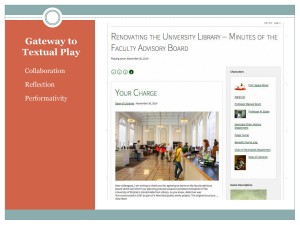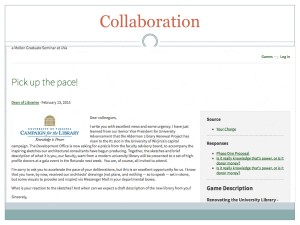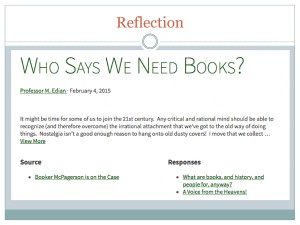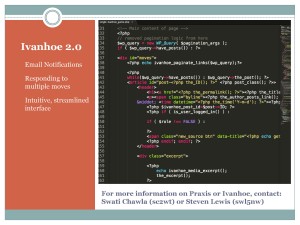The Praxis team was invited to two presentations the last week. The first at the Moving People/ Linking Lives Page-Barbour Symposium, and then at UVa’s Huskey Research Exhibition. With a lot of help from Praxis teammate Jennifer Grayburn, I prepared a slideshow showcasing a brief history of Ivanhoe and the work of the two Praxis cohorts.
My talk for the “Lighting Round” of Moving People/ Linking Lives and the presentation (with Steven Lewis) for the Huskey exhibition was modified only slightly from the following write-up (co-authored with Steven Lewis and Jennifer Grayburn):
The work that Steven and I presenting today is not our work alone: Ivanhoe was first developed by Jerome McGann, Johanna Drucker, and Bethany Nowviskie in the 2000s, and in its most recent avatar, it was updated by the Praxis cohort of 2013-14, our immediate predecessor. We stand before you representing— hopefully faithfully— our teammates Amy R Boyd, Andrew Ferguson, Joris Gjata, and Jennifer Grayburn. Our discussion today is focused on Ivanhoe’s use as a pedagogical aid, and we will be using examples from the game played by participants of the Mellon Graduate Seminar on Composing the Humanities in a Digital Age.
Ivanhoe grew out of a dissatisfaction: it was a dissatisfaction with limitations inherent in existing forms of interpreting texts, where readers felt the need for “a more imaginative form wanted to develop a more imaginative form of critical methodology.” We have chosen to describe Ivanhoe as a gateway for textual play. We define text in the broadest sense possible, and although the Ivanhoe game developed through the collaborative analysis of literature, we’ve expanded its scope to be inclusive of a variety of media. A text can be anything: a painting, a piece of music, a passage of fiction or nonfiction prose. We define “play” as the sort of playful collaborative interpretation of a text that occurs during the course of an Ivanhoe game.

Collaboration, Reflection, Performativity: Behind this layout is a commitment to three principles: Collaboration, Reflection, and Performativity.



Collaboration is fundamental to the mechanics of Ivanhoe gameplay since every game involves multiple players, and is composed of responses to the central textual object and responses to fellow players. Players work together to weave a discursive web around the central text of the game, and in doing so, they draw meaning out of the subject text in relation to each others’ responses. Like collaboration, reflection too is written into the mechanics of Ivanhoe gameplay, and it is this component that best distinguishes Ivanhoe from other forms of collaborative writing (fan fiction, for example). Not only are players making “moves,” they are required to reflect on these moves through the vantage point of their role vis-a-vis the text. The primary means through which we encourage reflection during games is the requirement that all players maintain a role journal. The journal is something that is separate from the gameplay itself and allows players to reflect on the choices they made in making their moves. It provides players a space dedicated to writing about the ways that their moves relate to the character they created, and think about the ways that their moves relate to the moves of the other players. Performativiy is what sets Ivanhoe apart from other modes of methods of solitary reflection, or forums such as “comments” sections on blogs. In short, Ivanhoe requires players to have a stake in the game as their respective “role”. When players create this role for themselves at the beginning of the game, they are expected to “perform” in that role for the duration of the game. This forces them to delve deeply into the implications of a given critical perspective, a particular location and point of view. It is also what makes the Ivanhoe game fun!

Next Steps:
The question that animates Ivanhoe is: how do we make a program that students want to engage with by choice, and not by force. Towards that end, we are working on three features this year:
-
Email notifications
Email notifications are an important addition in this version of the Ivanhoe game because players know immediately when a new move is made. This allows them to respond to each other quickly and keeps the game moving at a relatively fast pace. In our own experience playing the game, pacing–specifically knowing when moves have been made–is extremely important to keeping players engaged with the game currently being played.
-
Responding to multiple moves
This is another important functional addition to the first version of Ivanhoe, in which players could respond to only one move at a time responding to more than one move at once allows players to “stretch” the ways in which they perform their character. Responding to multiple moves will also open up different analytical possibilities and allow for drawing connections between larger groups of ideas.
-
Intuitive and streamlined interface
Our new interface is designed to allow more personalization by the game administrator and to increase functionality. We eliminated unnecessary visual clutter, reorganized information for more intuitive reading, and implemented options to change color schemes/game images.
In closing, we mentioned that Ivanhoe was being used in a class on John Milton’s Paradise Lost in Washington and Lee University, and that we were hoping to get some feedback from the players in a couple of weeks. In fact, I fortuitously met the instructor for this course at the Moving Peoples/ Linking Lives symposium.
The Questions:
Here are some of the questions that were posed to us after the two presentations. I hope to address some of them in future blogposts. Thoughts and comments welcome!
-
Has/ how does Ivanhoe been folded into classroom pedagogy?
-
Does/ how does Ivanhoe in its current for account for the difference between fiction and non-fiction?
-
You say so much about reflection and collaboration. But these assume responsible playing. How would a game of Ivanhoe deal with trolls?
-
Can you include your own performance as a response to a move?
The full powerpoint slides are here:
Ivanhoe at Moving People/ Linking Lives Ivanhoe at Huskey Research Exhibition
My Learnings:
Presenting our collective work was an honor for me, but also brought with up some questions of sharing credit and acknowledging the contributions of others. Luckily, all the thought (and love!) we had put into our charter at the beginning of the year came in handy. We had said: “All members of the Praxis Program team deserve equal credit for their contribution…. Our shared web site should always list general credit in alphabetical order to emphasize the non-hierarchical ethos of the program. Whenever a member of the Praxis Program references the work to the outside community, the project as a whole should be credited to all members.” Since one of these presentations involved a competitive event, we were told that we could not compete as a group of six. We decided as a team that it was okay for Steven and me to formally compete for the prize, as long as the work was credited to the whole team in the presentation and conference publicity materials. While working on a team project with a think tank in Delhi, I remember my mentor saying that a lot more gets done when everyone is generous with sharing credit. I am very glad we have lived up to the ethos of our charter and done exactly that!
